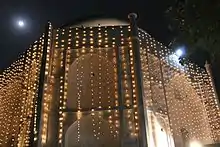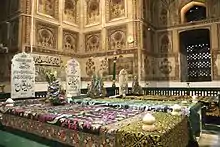Hazrat Ishaan
Khwaja Sayyid Mir Khawand Mahmud ibn Sharif Naqshbandi, known as "Hazrat Ishaan Shah Saheb" (1563 — 5 November 1642) is a Sufi Saint from Bukhara, Uzbekistan.[2]
Hazrat Ishaan Shah Saheb | |
|---|---|
 Darbare Hazrat Ishaan | |
| Born | 1563 |
| Died | 4 November 1642 (aged 79) |
| Resting place | Lahore |
| Title |
|
| Predecessor | Hazrat Bahauddin Naqshband (Uwaisiyyah line) |
| Successor | Mir Sayyid Moinuddin Hadi Naqshband, Sayyid Mir Jan (Uwaisiyyah line)[1] |
| Children | Moinuddin Hadi Naqshband |
| Parent(s) | Sayyid Mir Sharif Naqshbandi |
| Part of a series on |
| Islam |
|---|
 |
|
| Part of a series on Islam Sufism |
|---|
|
|
Ancestry
Hazrat Ishaan was a Sayyid, one who claims direct descent from the Islamic prophet Muhammad (in this case through his daughter Fatima al Zahra and his son in law and cousin Ali ibn Abu Talib).[3]
Paternal descendance
Two paternal Sayyid lineages of him are currently known. From one line he is a direct descendant of the seventh Imam Musa al Kadhim, through his son Ibrahim al Murtadha and of the well known Sufi master Khwaja Sayyid Mir Alauddin Atar. Sayyid Alauddin Atar was the successor and son in law of Hazrat Bahauddin Naqshband. Therefore, Hazrat Ishaan is also from the progeny of Hazrat Bahauddin Naqshband, who was himself a descendant of the eleventh Imam Hasan al Askari, through his son Sayyid Ali Akbar.[4][5][6] Hazrat Ishaan Saheb is also known to have a familiary relationship with the Sufi saint Farid ul-din Attar and Khwaja Ubaidullah Ahrar. Khwaja Ahrar was his ancestor, which also indicates Hazrat Ishaans descent from Caliph Umar ibn Al Khattab[7]
Maternal descendance
From his maternal line Hazrat Ishaan is of Hashimi descent from two lines. One line is linked to Imam Hussein though his maternal grandfather Marik ibn Zayn ul Abideen. Another line is linked to Imam Muhammad Ibn al Hanafiyyah.[8]
Biography
Family
Hazrat Ishaan was the second son of Khwaja Sayyid Mir Sharif Naqshbandi. His older brother was Khwaja Khawand Muhammad Naqshbandi, known as Khwaja Khawand Aftab, who also was a saint. Hazrat Ishaan had issued 5 daughters and 6 sons, who are all regarded as saints.[9]
Lineage
Registered lineages of him to the Prophet Muhammad, that are currently known are the following two:[10]
2. Ali ibn Abi Talib and Fatima Al Zahra
3. Imam Hussain
5. Imam Muhammad al Baqir
9. Imam Muhammad al Taqi
10. Imam Ali al Hadi
13. Sayyid Mir Mahmud Fakhriddin
14. Amir Sayyid Mir Muhyuddin
15. Amir Sayyid Mir Khalwati
16. Amir Sayyid Mir Naqi Naqib
17. Sayyid Mir Ilaq
18. Sayyid Mir Mahmud
19. Sayyid Mir Burhan Qilchy
20. Sayyid Mir Shaaban
21. Sayyid Mir Qasim
22. Sayyid Mir Zayn ul Abedin
23. Sayyid Mir Abdullah
24. Sayyid Mir Burhanuddin Qilchy
25. Amir Sayyid Mir Jalalludin Muhammad Bukhari
26. Amir Sayyid Burhanuddin Muhammad Bukhari
27. Hazrat Khwaja Sayyid Mir Bahauddin Naqshband[11]
28. Shahe Naqshband´s daughter and her husband Khwaja Sayyid Mir Alauddin Attar
29. Hazrat Khwaja Sayyid Mir Hussain Atar Bukhari
30. Hazrat Khwaja Sayyid Mir Tajuddin Hussain
31. Hazrat Khwaja Sayyid Mir Muhammad
32. Hazrat Khwaja Sayyid Mir Zia ul Din
33. Hazrat Khwaja Sayyid Mir Sharif
34. Hazrat Khwaja Sayyid Mir Khawand Mahmud, also known as Hazrat Ishaan
2. Imam Ali ibn Abi Talib and Fatima Al Zahra
3. Imam Hussain
8. Sayyid Mir Ibrahim
9. Sayyid Mir Abu Bakr al-Kabir
10. Sayyid Mir Abdul-Haq
11. Sayyid Mir Jafar
12. Sayyid Mir Muhammad Rumi
13. Sayyid Mir Abdullah
14. Sayyid Mir Musa
15. Sayyid Mir Hussein
16. Sayyid Mir Qasim
17. Sayyid Mir Abu Bakr Reza
18. Sayyid Mir Abdullah Zarbakhsh
19. Sayyid Mir Muhammad Khwarezmi
20. Khwaja Alauddin Attar
21. Hazrat Khwaja Sayyid Mir Hussain Atar Bukhari
22. Hazrat Khwaja Sayyid Mir Tajuddin Hussain
23. Hazrat Khwaja Sayyid Mir Muhammad
24. Hazrat Khwaja Sayyid Mir Zia ul Din
25. Hazrat Khwaja Sayyid Mir Sharif
26. Hazrat Khwaja Sayyid Mir Khawand Mahmud, also known as Hazrat Ishaan
The significance of his lineage is an evidence for descendants of Imam Hasan al-Askari.
Spiritual journey
Hazrat Ishaan was influenced by his ancestors´ teachings and was therefore a disciple of his father.[12] Hazat Ishaan was granted permission from his father to study in a royal college and had become an accomplished scholar.[13] In the age of 23 years Hazrat Ishaan Shah Saheb has received a letter to visit his father and to accompany him in his last days.[14] Upon his father, passing away, he abandoned further studies and concentrated on the mystical quest.[15] In this he first left to Wakhsh,[16] where he became Shaykh ul Islam, performing his duties there.[17] While staying in Wakhsh, he got to know Khwaja Hajji.[18] They have met a second time in Balkh, where Khwaja Hajji has introduced him to his future master Khwaja Ishaq Dahbidi and has become his disciple.[19] He met him the second time in Bokhara and has become his disciple.[20] After twelve years of spiritual training Hazrat Ishaan Saheb has reached the level of a Shaykh in Tasawuff in year 1598.[21] Khwaja Ishaq Wali has welcomed him in his circle as the emperor of all Awliya Allah. On the order of Khwaja Ishaq Wali Hazrat Ishaan Saheb went to Lahore to propagate the Ishaqqiya path. Instead he went to Srinagar in Kashmir. In Srinagar he attracted many people, who have later followed him. The fame of his piety has reached many areas of Central Asia.[22] Hundreds of thousands of disciples in Khorasan, modern-day Afghanistan, especially in the cities of Kandahar, Kabul and Herat, followed him.[23] He has sent disciples in all over Central Asia under, whom 2 have been sent to Tibet. Unlike other Naqshbandi Masters he attracted many people, who were not only official patronages.[24] Hazrat Khwaja Khawand Mahmud was invited by the Moghul Emperor Jahangir to go to his court in Agra. Going there several times, he was unable to create firm connections to the court, because of the influences of Naqshbandis attached to the rival Jubairiyya branch.[25][26] Therefore, he came back to Kashmir. Becoming entangled in the struggle against the Shia community there, Moghul emperor Shah Jahan summoned him in year 1636 to Delhi and banned his way to Srinagar. Hazrat Ishaan spent his last six years in Lahore, where he also died.[27][28][29]
Succession
Hazrat Ishaan was succeeded by his son Moinuddin Naqshabnd in Kashmir.[30] His youngest son Bahauddin succeeded his father in Lahore in a very young age. His spiritual line died out in the late eighteenth century. Hazrat Ishaan has stated that one of his progeny will come to revive his lineage and to take his place as Ghawth. It has been found, that Hazrat Sayyid Mir Jan is this person, who is his successor in the Uwaisiyyah way.[31]
Spiritual rank
Hazrat Ishaan was Qutb ul Aqtab, also called Ghawth, the highest ranking Wali Allah (saint) of his time. In Sufism the Ghawth is known as the cosmic leader of the whole universe and righteous successor of prophet Muhammad. It is said that Hazrat Ishaan stated that under his progeny there will come a son of him, who will revive the spiritual lineage and legacy of Hazrat Ishaan and who will take his place as Ghawth after him. His successor is Sayyid ul Sadaat Hazrat Sayyid Mir Jan.[32][33]
Gallery



See also
- Abdul Qadir Jilani
- Sultan Sadaat Sayyid Ali Akbar
- Ali Hujwiri
- Bahauddin Naqshband
- Moinuddin Chishti
- Sayyid Mir Jan
- Sayyid Mahmud Agha
- Ziyarat Naqshband Sahab
Website about Hazrat Ishaan: www.hazrat-ishaan.com
References
- Tazkare Khwanadane Hazrat Eshan(genealogy of the family of Hazrat Eshan)(by author and investigator:Muhammad Yasin Qasvari Naqshbandi company:Edara Talimat Naqshbandiyya Lahore)p. 65
- Tazkare Khwanadane Hazrat Eshan(genealogy of the family of Hazrat Eshan)(by author and investigator:Muhammad Yasin Qasvari Naqshbandi company:Edara Talimat Naqshbandiyya Lahore)p. 58
- Tazkare Khanwade Hazrat Ishaan, p. 61, by Muhammad Yasin Qaswari Naqshbandi, published by Kooperatis Lahorin, Edare Talimat Naqshbandiyya
- "Naqshbandiya shajarasi izidan". Archived from the original on 2017-08-03. Retrieved 2017-08-03.
- "Ҳазрат Хожа Баҳоуддин Нақшбанд". Archived from the original on 2017-08-03. Retrieved 2017-08-03.
- Tazkare Khwanadane Hazrat Eshan(genealogy of the family of Hazrat Eshan)(by author and investigator:Muhammad Yasin Qasvari Naqshbandi company:Edara Talimat Naqshbandiyya Lahore) p. 57-63
- Damrel in Forgotten Grace, p. 20, l. 13-16
- Tazkare Khwanadane Hazrat Eshan(genealogy of the family of Hazrat Eshan)(by author and investigator:Muhammad Yasin Qasvari Naqshbandi company:Edara Talimat Naqshbandiyya Lahore)p. 55
- Tazkare Khwanadane Hazrat Eshan(genealogy of the family of Hazrat Eshan)(by author and investigator:Muhammad Yasin Qasvari Naqshbandi company:Edara Talimat Naqshbandiyya Lahore) p. 58
- Tazkare Khwanadane Hazrat Eshan(genealogy of the family of Hazrat Eshan)(by author and investigator:Muhammad Yasin Qasvari Naqshbandi company:Edara Talimat Naqshbandiyya Lahore) p. 62 f.
- "Shajara-e-nasab lineages of descendants of Imam Hasan al-Askari r.a.-Shajara.org". Retrieved 2020-06-29.
- Tazkare Khwanadane Hazrat Eshan(genealogy of the family of Hazrat Eshan)(by author and investigator:Muhammad Yasin Qasvari Naqshbandi company:Edara Talimat Naqshbandiyya Lahore)p.57
- http://www.nazariapak.info/Sufism/Hazarat-Ehsan.php
- Damrel in Forgotten Grace, p. 50, l. 13-15
- Damrel in Forgotten Grace, p. 50, l. 15-17
- Damrel in Forgotten Grace, p. 51, l. 3
- Damrel in Forgotten Grace, p. 6, l. 5
- Damrel in Forgotten Grace, p. 59, l. 17-20
- Damrel in Forgotten Grace, p. 60, l. 1
- Damrel in Forgotten Grace, p. 60, l. 7-11
- Damrel in Forgotten Grace, p. 61, l. 17-20, p. 62, l. 1, 2
- "the Naqshbandiyya: Orthodoxy and activism in a worldwide Sufi tradition" written and investigated by: Itzchak Weismann ;company: Routledge Taylor&Francis Group(p.52)
- http://www.nazariapak.info/Sufism/Hazarat-Ehsan.php
- "the Naqshbandiyya: Orthodoxy and activism in a worldwide Sufi tradition" written and investigated by: Itzchak Weismann ;company: Routledge Taylor&Francis Group(p.52)
- "the Naqshbandiyya: Orthodoxy and activism in a worldwide Sufi tradition" written and investigated by: Itzchak Weismann ;company: Routledge Taylor&Francis Group(p.52)
- http://www.nazariapak.info/Sufism/Hazarat-Ehsan.php
- Tazkare Khwanadane Hazrat Eshan(genealogy of the family of Hazrat Eshan)(by author and investigator:Muhammad Yasin Qasvari Naqshbandi company:Edara Talimat Naqshbandiyya Lahore)
- "the Naqshbandiyya: Orthodoxy and activism in a worldwide Sufi tradition" written and investigated by: Itzchak Weismann ;company: Routledge Taylor&Francis Group(p.52)
- http://www.nazariapak.info/Sufism/Hazarat-Ehsan.php
- "the Naqshbandiyya: Orthodoxy and activism in a worldwide Sufi tradition" written and investigated by: Itzchak Weismann ;company: Routledge Taylor&Francis Group(p.52)
- Tazkare Khwanadane Hazrat Eshan(genealogy of the family of Hazrat Eshan)(by author and investigator:Muhammad Yasin Qasvari Naqshbandi company:Edara Talimat Naqshbandiyya Lahore) p.65
- Tazkare Khwanadane Hazrat Eshan(genealogy of the family of Hazrat Eshan)(by author and investigator:Muhammad Yasin Qasvari Naqshbandi company:Edara Talimat Naqshbandiyya Lahore)
- Sufi Sheikhs of Pakistan and Afghanistan
